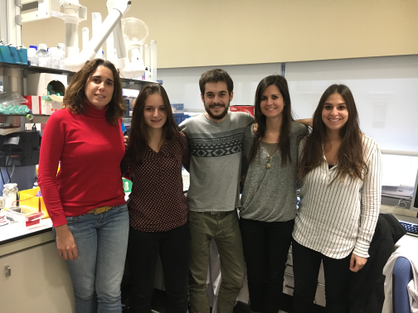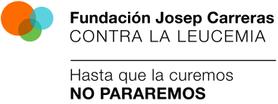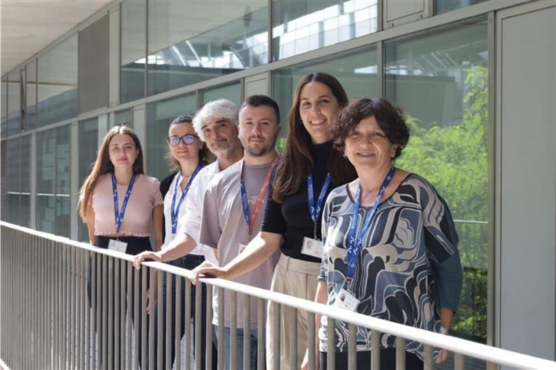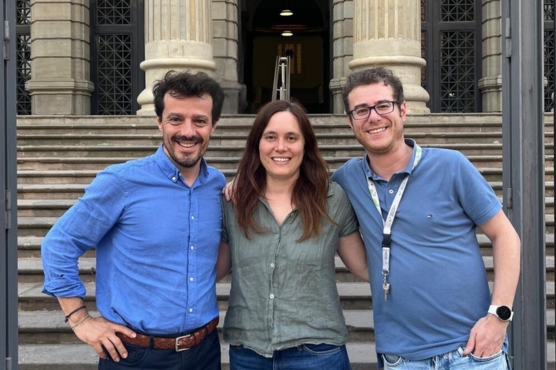• The Josep Carreras Leukaemia Research Institute’s (IJC) acute myeloid leukaemia research group, directed by Dr. Ruth M. Risueño, has published a paper in the prestigious journal Leukemia, considered to be the most important journal in the field of hematology.
• The study, the main author of which is Amaia Etxabe, has identified the importance of the serotonin receptor type 1 (HTR1) for therapy in acute myeloid leukaemia (AML).
• Acute myeloid leukaemia (AML) is the most common leukaemia in adults and accounts for 40% of all leukaemias in the western world. It is estimated that every year there are 15 new cases per million in our country.
Dr. Ruth M. Risueño’s group has recently identified a new mechanism to combat acute myeloid leukaemia. The results of the study have been published in the journal Leukemia, a world standard bearer in the field of hematology. This study, the main author of which is the researcher Amaia Etxabe, describes a specific potential therapy for leukaemia stem cells.
Acute myeloid leukaemia was the first tumour in which a population of leukaemia stem cells was described. These are cells with the same properties as normal stem cells, so they have the capacity to reproduce malignant cells.
With standard chemotherapy, the rates of remission for this kind of leukaemia are currently between 50% and 85%, although most patients suffer a relapse of the disease. The leukaemia stem cells are the population of cells within the tumour responsible for initiating and maintaining the disease and for causing a relapse. For this reason treatment must eradicate them so that the disease can be eliminated completely.
During their research, the IJC group found that leukaemia cells express the serotonin receptor type 1 (HTR1)on their surface. The HTR receptors are typically associated with the nervous system, and this is the first time that their implication in the cancer process has been identified.
The inhibition of this receptor would lead to the destruction of this kind of leukaemia cell, but would have a minimal effect on healthy blood cells.
The study therefore shows the importance of HTR1 in the production of this kind of leukaemia and identifies this group of receptors as a new therapeutic target in AML with prognosis value.
More information: http://www.nature.com/leu/journal/vaop/ncurrent/abs/leu201752a.html
Acute myeloid leukaemia
Acute myeloid leukaemia (also known as acute myeloblastic leukaemia, acute myelogenous leukaemia, acute granulocytic leukemia and AML) is the most common sort of leukaemia in adults. Under normal conditions the bone marrow produces cells called myeloblasts which, after maturing, differentiate into granulocytes, cells that are responsible for the body’s defences against infection.
In AML the cells of the myeloid series (myeloblasts) proliferate in an abnormal manner and progressively invade the bone marrow, interfering with the production of healthy blood cells, and this leads to bone marrow insufficiency and the infiltration of tissues outside the bone marrow.
Sometimes AML is the final stage of other diseases such as myelodysplastic syndromes and chronic myeloproliferative syndromes. It has a high incidence amongst patients with certain chromosome alterations such as in Down syndrome and Fanconi anemia.
The average age of patients with AML is 64 and most patients are between the ages of 60 – 75. There are more than seven subtypes of the disease and they have very different prognoses and treatments.
The Josep Carreras Leukaemia Foundation
The Josep Carreras Leukaemia Research Institute (IJC), a Government of Catalonia (Generalitat de Catalunya) CERCA research centre, was founded in 2010 in collaboration with the Catalan government with the aim of strengthening biomedical research and personalised medicine in the field of leukaemia and other malignant blood diseases. The Institute is unprecedented and it brings together the endeavours and professional rigour of world-class basic and clinical researchers. It employs the most innovative technologies, cooperates on many multi-centre projects and competes successfully both at home and abroad. Its scientific output, already very considerable in volume and of great importance, is published in the most prestigious journals.
During this year 2017 will inaugurate the new building of the Josep Carreras Leukaemia Research Institute in the ICO/Germans Trias i Pujol Campus (Campus Can Ruti). Its 7,000 m2 will be devoted to leukaemia research.
The IJC has three independent but coordinated scientific campuses:
• The University of Barcelona Hospital Clínic Campus, located at the facilities of the University of Barcelona Faculty of Medicine and those of the Hospital Clínic, Barcelona.
• The Catalan Institute of Oncology/Germans Trias i Pujol Campus, located near the Germans Trias i Pujol University Hospital in Badalona and its Research Foundation, and at the Autonomous University of Barcelona (UAB) Germans Trias i Pujol Teaching Department.
• The Sant Pau Campus, located near the Hospital de Sant Pau in Barcelona, the UAB Faculty of Medicine and the Sant Pau Biomedical Research Institute.
About Josep Carreras Leukaemia Foundation
The Josep Carreras Leukaemia Foundation was established in 1988 with the aim of helping to find a definitive cure for this disease. Its efforts are focussed on three main areas: scientific research, carried out at the Josep Carreras Leukaemia Research Institute; managing Spain’s bone marrow register (REDMO); and improving the quality of life for patients. The Foundation has already committed more than €20,000,000 for the construction and equipping the IJC campuses.










